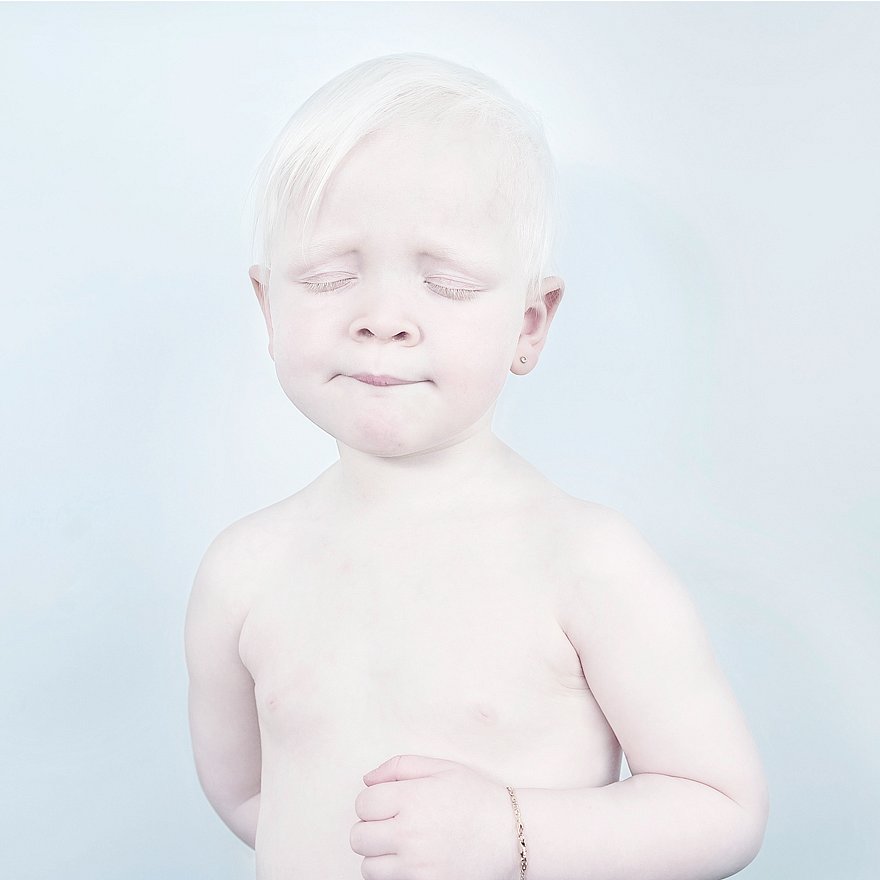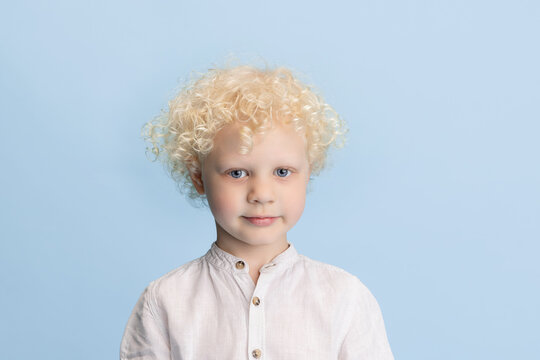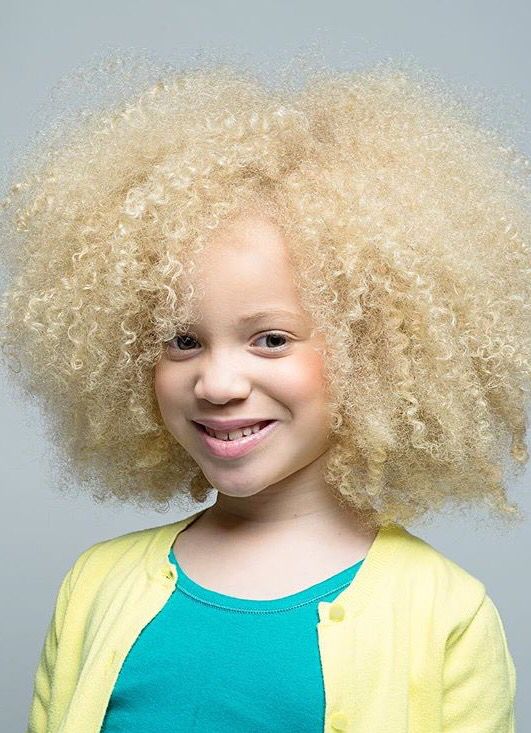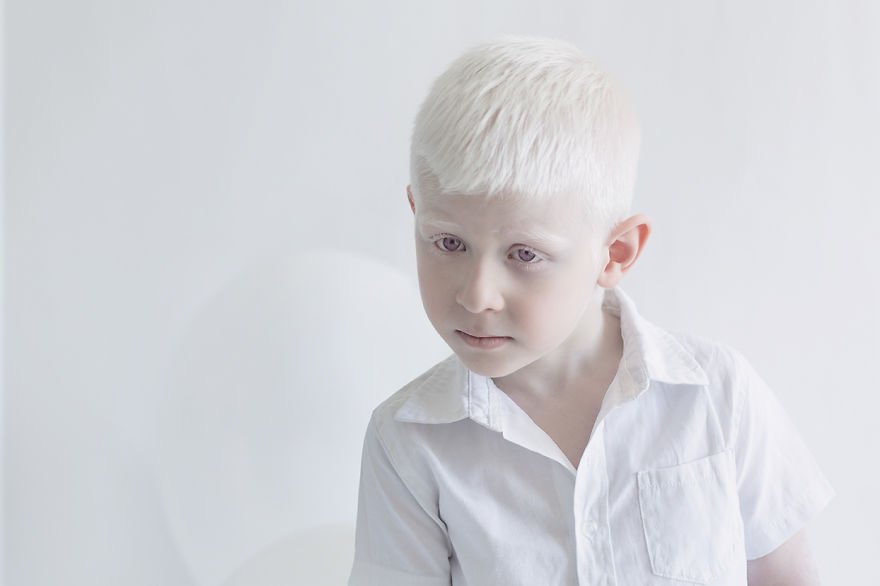Yes, albino people can dye their hair. However, due to the absence of melanin, the process and results might differ from dyeing hair with melanin. Albino individuals should be aware of potential challenges such as quicker fading and possible unexpected color outcomes.
Moreover, The vibrant world of hair color offers a canvas for self-expression and personal style. From subtle highlights to bold, eye-catching hues, the ability to change one’s hair color has become an art form that transcends cultural boundaries.
However, for individuals with albinism, a genetic condition characterized by the absence or reduction of pigment in the skin, hair, and eyes, questions often arise regarding the feasibility and safety of dyeing their unique hair.
In this exploration, you will delve into the considerations and possibilities surrounding hair dye for people with albinism.
What is albinism?

Albinism is a genetic condition characterized by a lack or deficiency of melanin pigment in the skin, hair, and eyes. Melanin is the pigment responsible for the color of these tissues.
In addition, People with albinism have a reduced ability to produce melanin, which results in a unique appearance with pale or white skin, hair, and light-colored eyes. This condition is caused by inherited gene mutations that interfere with the production of melanin.
There are different types of albinism, but the two main categories are:
- Oculocutaneous Albinism (OCA): This type affects the eyes, skin, and hair. People with OCA have little to no melanin in these tissues, which can lead to sensitive skin, increased susceptibility to sunburn, and vision problems due to the lack of melanin in the eyes.
- Ocular Albinism (OA): This type primarily affects the eyes. While skin and hair may have some melanin, the eyes still lack enough melanin, leading to vision problems such as reduced visual acuity and depth perception.
Albinism is typically inherited in an autosomal recessive manner, meaning that both parents need to carry a copy of the mutated gene for their child to be affected. The severity can vary, and individuals with albinism might have different levels of pigmentation and visual impairments.
Due to the lack of melanin, individuals with albinism are often more susceptible to the harmful effects of UV radiation from the sun, which can lead to sunburn, skin damage, and an increased risk of skin cancer. Additionally, vision problems are common among individuals with albinism, including issues like nearsightedness, farsightedness, and involuntary eye movements (nystagmus).
Besides, It is a rare condition, and individuals with albinism may face unique challenges related to their appearance, vision, and overall well-being. While there is no cure for albinism, supportive measures such as sun protection, vision correction, and assistive technologies can help individuals with albinism manage their condition and lead fulfilling lives.
Navigating Hair Dyeing for Albinism-Affected Hair: Key Considerations
When embarking on the journey of dyeing hair influenced by albinism, several crucial aspects demand meticulous attention. The distinctive nature of hair affected by albinism underscores the importance of thoughtful planning and execution.
Safeguarding Sensitivity: A Gentle Approach The inherent sensitivity and susceptibility of albinism-affected hair require a careful approach. Opting for hair dyes that prioritize gentleness and exclude ammonia is paramount to prevent potential damage and minimize any adverse effects.
Coloring Challenges: Realistic Expectations Achieving the desired color outcome on hair with minimal pigmentation can be a complex task. Unlike hair rich in melanin, obtaining the envisioned hue might necessitate different techniques. Consulting with a seasoned colorist who understands diverse hair types helps set realistic color expectations and ensures the best possible results.
Skin Health Matters: Sensitivity and Allergies Albinism often comes hand in hand with delicate skin and potential sensitivities. Prioritizing the well-being of the scalp is essential. Before proceeding, conducting a patch test is crucial to preempt any adverse reactions. Additionally, selecting hair dye products specially formulated for sensitive scalps aids in mitigating the risk of irritation.
Engaging the Expertise: Professional Guidance for Optimal Results Collaborating with a hairstylist well-versed in catering to individuals with albinism is a pivotal step. Their insights, based on experience with unique hair characteristics, ensure a safe and effective dyeing process, culminating in a result that embraces both the individual’s desires and their distinct hair traits.
Pros and Cons
Pros:
- Color Expression: Individuals with albinism possess the capacity to dye their hair akin to anyone else. Hair dye functions by artificially infusing colour into the hair shaft, making it effective on albino hair as well.
- Vivid Experimentation: Dyeing offers albinos an opportunity to explore a diverse palette of vibrant and playful hair colours such as pink, blue, or purple. These shades distinctly stand out against their pale hair backdrop.
- Camouflaging Options: Dyeing permits the option to conceal or harmonize with the bright white hair. Opting for darker shades like brown can facilitate a semblance of normalcy.
Cons:
- Risk of Damage: Inadequate dyeing procedures can potentially harm the delicate structure of albino hair, which is inherently susceptible to dryness. Prudent utilization of chemicals is imperative to avoid damage.
- Color Retention Challenges: Due to the lack of melanin in albino hair, the adherence and durability of colour can be compromised, leading to faster fading of the dye.
- Bleaching Sensitivity: The lightening or bleaching process carries inherent risks. Harsh bleaching agents can exacerbate the fragility of albino strands, causing undue dryness.
How to Color Albino Hair
Preparing Your Hair for the Dyeing Journey
Prior to embarking on the dyeing adventure, it’s crucial to lay a strong foundation for a successful process. Follow these essential steps:
1. Select Your Desired Hue: Begin by choosing the color shade that resonates with you. Utilize hair color try-on apps or programs, such as Loreal Paris’s virtual try-on app, to visualize how the chosen color will suit you.
2. Gather the Essentials: Once you’ve settled on the right dye, gather your tools. Prepare clarifying shampoo, semi-permanent hair dye, clips, vaseline, a plastic bowl, a tinting brush, gloves, a plastic cap, and a blow dryer.
3. Dress Thoughtfully: Don an old t-shirt or drape a garbage bag around your shoulders to shield your clothing from potential staining. Safeguard your environment by placing towels at your feet to catch any drips.
Begin the Dyeing Ritual
- Prepare Your Canvas: A few days prior to dye day, cleanse your hair thoroughly with clarifying shampoo, omitting conditioning. This ensures that residue doesn’t interfere with dye adhesion.
- Create a Protective Barrier: On dye day, apply a layer of Vaseline around your hairline, top half of your ears, and the nape of your neck. This acts as a protective shield between your skin and the dye.
- Sectioning for Precision: Divide your hair into manageable sections, using clips to keep them separate. Four to six sections usually suffice for most individuals.
- Blend and Apply: Dispense the chosen hair dye into a plastic bowl, then gently mix it using gloved hands and the tinting brush.
- Artful Application: Begin the dye application section by section, starting at the roots. Thorough saturation is paramount for albino hair, as it can react differently to dyes.
- Patience in Processing: Allow the dye to develop on your hair for a minimum of 45 minutes. Utilize a plastic cap and introduce heat using a blow dryer or hooded dryer. Refer to the dye’s packaging for longer processing times if applicable, as this prolongs the vibrancy of the color
- Seal the Hue: After the processing time, rinse your hair with cold water, followed by a conditioner application to lock in the color.
How long will hair dye last in albino hair?

Typically, the longevity of hair dyeing spans around 4-6 weeks for individuals with albinism, marking the point at which noticeable fading takes center stage. This interval contrasts with the enduring period of 6-8 weeks often experienced by those with pigmented hair.
Several factors contribute to this relatively shorter duration:
Melanin’s Adhesive Role: Melanin, with its adeptness at gripping and adhering to artificial dye molecules, plays a vital role. With diminished melanin binding capabilities, the color’s tenacity wanes more swiftly.
Hair’s Intricate Nature: Albino hair, characterized by inherent dryness and fragility, possesses its own intricacies. As strands naturally shed over time, the tinted sections relinquish their grip earlier.
Vulnerability of Chemical Processing: Delicate albino hair can be sensitive to chemical processes. The hair’s cuticle might not seal as tightly, allowing color molecules to make an early escape.However, the allure of vibrant color can be prolonged with a few strategies:
Embrace Ammonia-Free Alternatives: Opting for ammonia-free semi-permanent hues, which envelop the hair shaft without penetrating, becomes a game-changer in deferring fading.
Gentle Cleansing Habits: Infrequent shampooing, exclusively with sulfate-free formulas, emerges as a wise practice to minimize color stripping.
Cool Rinses and Minimal Washing: Opting for cool water over hot for rinsing, coupled with refraining from excessive washing, preserves color brilliance.
Hydrating Rituals: The weekly inclusion of a nourishing hair mask rehydrates strands and effectively locks in the color’s radiance.
Sustaining the Luster: Reapplying and Tender Loving Care.
A prudent strategy involves reapplication of dye to both roots and lengths every 3-4 weeks. This consistent approach maintains the allure of freshly vibrant hair. With tender loving care and these measures, the dye’s longevity on albino hair can be respectably extended, allowing the hues to gracefully shine on.
How To Deep Condition Albino Hair After You Dye Your Hair?
Deep conditioning emerges as a pivotal element in nurturing delicate albino hair following the dyeing journey. Here’s a guide to effective post-dye deep conditioning:
Patience in Timing: Allow a window of 2-3 days before delving into deep conditioning. This interval permits the hair’s cuticle to naturally close and stabilize after the chemical process. Until then, opt for rinsing with pure water.
Embrace Protein-Rich Masks: Opt for a lush hair mask that’s abundant in proteins. Seek out ingredients such as keratin, shea butter, argan oil, and coconut oil. Exercise caution by avoiding silicones.
Methodical Application: Amid the shower, apply a generous coat of the chosen hair mask, generously covering each strand from root to tip. This step comes after your shampoo routine.
Encourage Soaking: Encase your hair in a shower cap, enabling the mask to soak in and work its magic for a minimum of 15 minutes, extending up to 30 minutes for enhanced benefits. Rinse diligently afterward.
Protect with Restraint: Exercise restraint in resorting to heat styling for a duration of a week or longer. This preventive measure safeguards vulnerable strands from potential damage.
A Routine of Nourishment: Incorporate the deep conditioning treatment into your routine 1-2 times weekly. This practice effectively counters the drying effects while upholding the vibrancy of the dye’s color.
Take care of your albino hair when dying your hair
- Patch Test for Allergies: Always conduct a patch test to identify potential allergies before dyeing your full head.
- Prefer Semi-permanent or Demi-permanent Dyes: Opt for semi-permanent or demi-permanent dyes to steer clear of harsh bleaches and ammonia.
- Shorter Processing Time: Process the dye for a duration less than the maximum suggested time to prevent excessive chemical penetration.
- Gentle Hair Cleansing: Thoroughly cleanse your hair using cool water and a sulfate-free shampoo for effective washing.
- Natural Air Drying: Allow your hair to air dry naturally, avoiding heat styling to protect delicate strands.
- Strengthen with Bonding Serum or Olaplex Treatment: Utilize a bonding serum or Olaplex treatment to fortify hair bonds.
- Regular Trims for Maintenance: Schedule periodic trims to remove split ends and promote overall hair well-being.
- Mindful Heat Styling: When using heat styling, opt for lower heat settings and let your hair rest overnight.
What Hair Color Will Suit Albino People?
Determining the most suitable hair color for individuals with albinism is a matter of personal inclination, influenced by style preferences and the desired image projected. The choice of hair color is unbounded, devoid of rigid rules or confines, allowing albino individuals to explore a broad spectrum of shades to uncover the one that resonates with their personality and inclinations. Nevertheless, several factors warrant consideration while electing a hair color for individuals with albinism:
- Complexion Harmony: While albinism typically entails fair skin, nuances in undertones can impact the visual impact of a chosen hair color. Identifying whether the skin carries cool, warm, or neutral undertones is pivotal in selecting a shade that complements the complexion adeptly.
For instance, cool-toned hues, like ash blonde or blue, might elegantly complement cool skin undertones, whereas warm-toned colors, such as golden blonde or copper, could harmonize well with warmer undertones.
- Eye Color Interaction: The eye color further contributes to the decision-making process. Opting for a shade that either harmonizes or strikingly contrasts the eye color can contribute to an aesthetically pleasing and attention-grabbing appearance.
- Individual Aesthetics: Tailoring the hair color choice to align with personal inclinations and distinctive style is pivotal. Albino individuals possess the latitude to experiment across a wide spectrum of tones, ranging from natural-looking hues to audacious and vivid shades, in accordance with their envisaged aesthetic.
- Maintenance Aspect: The chosen hair color might necessitate varying degrees of upkeep and additional attention to preserve its allure. Opting for a low-maintenance hue can be pragmatic, especially for individuals leading a bustling lifestyle or grappling with limited time for hair care.
- Interim Alternatives: For those with an inclination to test diverse colors without committing to an irreversible transformation, temporary hair color solutions, such as hair chalk, colored sprays, or semi-permanent dyes, offer a versatile and reversible approach to experimenting with different looks.
Are there any specific hair dyes recommended for people with albinism?

When considering suitable and safe hair dyes for individuals with albinism, it’s recommended to opt for products designed for sensitivity. Focus on dyes explicitly formulated for grey or white hair, as they tend to be gentler on delicate, melanin-lacking hair.
Always conduct a patch test before fully dyeing the hair, and follow up with a nourishing deep conditioning treatment to maintain hair health.
| Brand | Features |
| Clairol Natural Instincts | – Formulated for grey hair without ammonia or bleach. |
| – Utilizes a gentler amino acid dye method. | |
| Madison Reed Radiant Hair Color | – Ammonia-free gel-based formula. |
| – Enriched with keratin, argan oil, and shea butter for conditioning. | |
| Overtone Coloring Conditioner | – Offers daily use colored conditioner in temporary, fun shades. |
| – Temporarily coats strands with color. | |
| Manic Panic | – Cream semi-permanent dye available in vivid hues. |
| – Free from peroxide or ammonia. | |
| Arctic Fox Hair Color | – Vegan product not tested on animals. |
| – Formulation excludes harsh chemicals. |
Please note that product formulations and availability might change, so it’s advisable to check the latest information before making a purchase.
Does Albino Hair Hold Dye?
Yes, albino hair can retain dye, although the process and results may differ from hair with melanin. The absence of melanin in albino hair presents distinct challenges and outcomes when attempting to color it. Consider the following:
Lighter Color Absorption: Due to its naturally light shade, albino hair might readily absorb dye, potentially leading to intense coloration beyond expectations. However, the lack of underlying pigment could also result in unexpected hues based on the chosen dye.
Uniformity Concerns: Albino hair’s varying levels of porosity could create uneven dye absorption, affecting the consistency of the color achieved.
Color Retention and Porosity: The elevated porosity of albino hair might cause dye to fade more swiftly than in melanin-rich hair. Consequently, maintaining the desired shade may necessitate more frequent color touch-ups.
FAQ
Best hair colours for albinos.
- Bold neon shades
- Pastels
- Platinum blonde
- Silver
- Vibrant red
- Electric pink
- Ginger
- Fantasy colours
- Dark brown/black
Is Albino Hair Harder To Dye Than Regular Hair?
No, it’s not harder to dye. The misconception stems from the difficulty of dyeing naturally white or gray hair due to its aging characteristics. Aging hair loses pigment, collagen, and natural lubrication, making it more resistant to dye. However, these factors don’t apply to albino hair, which lacks pigment. Albino hair can be dyed like regular hair without added difficulty. One consideration is that albino hair is more susceptible to UV damage, so sun protection is important, but this doesn’t affect the dyeing process.
Is Natural Albino Hair the Same as Bleached Platinum Hair?
No, they are not the same. Albino hair is untouched and unprocessed, while bleached platinum hair undergoes chemical lightening and can be quite damaged due to the process.
If an Albino Person Dyed Their Hair a Dark Color, Will It Damage Their Hair?
Generally, dyeing dark colors onto albino hair won’t cause severe damage. However, like any hair dyeing process, there are potential risks. It’s important to choose ammonia-free dyes and be aware of possible issues like pigmentation, excess hair growth, scalp irritation, and hair loss. Consulting a professional can help mitigate risks.
Can Albino People Develop Grey Hair?
Yes, albino people can develop grey hair as they age. Grey hair is caused by a natural reduction in melanin production, which occurs in both individuals with albinism and those without.
Can Albino Individuals Be in the Sun?
Yes, albino individuals can be in the sun, but they are more sensitive to its effects due to their lack of melanin, which provides natural protection from UV rays. To stay safe, they should use sunscreen, wear protective clothing, and avoid peak sun hours.
Conclusion:
To wrap up, the question of whether albino individuals can dye their hair is undoubtedly affirmative, yet it necessitates a nuanced approach. Albino hair, devoid of melanin, provides a distinctive canvas for the art of hair dyeing. While the process offers avenues for self-expression, it also demands careful consideration.
Furthermore, factors such as color absorption, fading tendencies, and potential unexpected shades should be taken into account.
However, armed with knowledge and guided by professional insights, albino individuals can confidently embark on this transformative journey. By exercising prudence, utilizing suitable products, and seeking expert advice, they can navigate the terrain of hair dyeing, ensuring that their individuality is both celebrated and respectfully nurtured.












